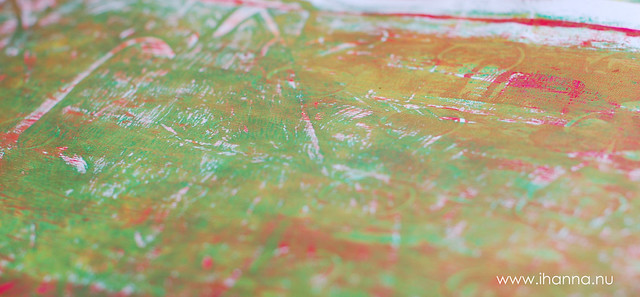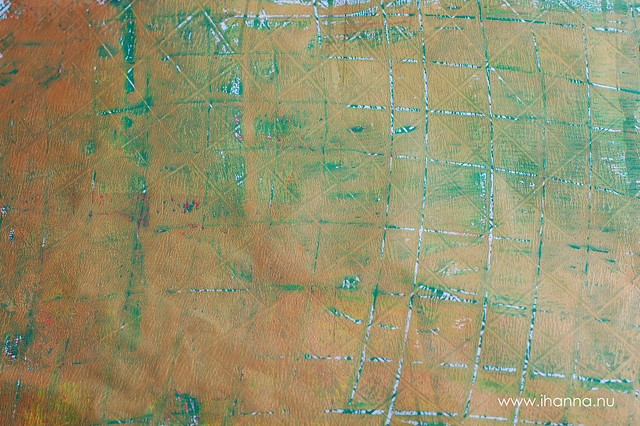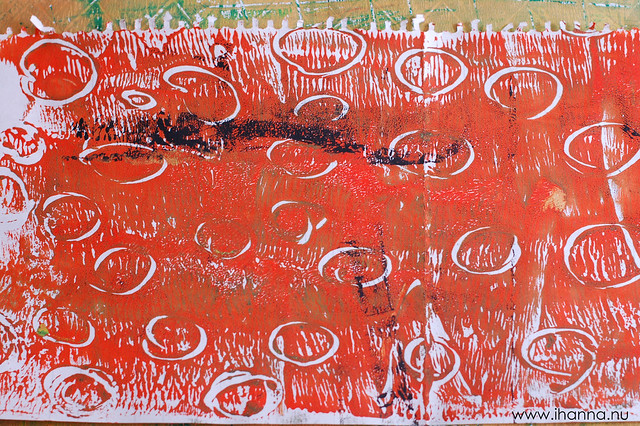Monoprinting Experiments
I’ve been watching a few fun videos about how to use a gel printing plate. I’m not sure what makes such a thing special or if it’s sold here in Sweden but I just imagined any surface where the paint wouldn’t stick would work… So I took out a big white piece of tile that I got in a class last year (as a working surface for melting stuff).
Then I rolled a layer of paint on top of the tile, using a brayer, made some marks and pressed a piece of paper to the surface. Hence – monoprinting I’m guessing it’s called. Love the result, especially this gold and green mix:
Have you done any gel printing? Does your prints look like these?
Please let me know if you have experimented with this – and what I should try – or think about the next time I try monoprinting…
It was fun drawing into the wet paint and then “printing” without knowing what the result would look like. I love that kind of serendipitous surprises!
Maybe I shouldn’t be so stubborn and just cave in and order a real gel printing plate? What do you think, do I need one? In the Gelli Arts video they only list that it’s durable and always ready as the two advantages over other surfaces… That’s it?
To get started, watch Jane Davies gel plate video for example.
Discover more from iHannas Blog
Subscribe to get the latest posts sent to your email.






Hi Hanna,
It took a while to convince myself to buy one but I have to say that I’m so glad I did. The chief advantage to a gel printing plate (whether homemade or commercial) is that there is a bit of give (bounce) in the surface which yields better, clearer prints. I’ve printed on tile (and glass and plastic) as well and the prints just aren’t as crisp as with a gel plate. The plate cleans up easy with a squirt of water and a paper towel. It does have to be stored flat without anything on top of it as you don’t want anything making a lasting mark on the surface of the plate. Tammy at Daisy Yellow uses homemade gelatin plates and gets incredible results but I just knew I wouldn’t want to make one myself. Oh, and if you do break down and buy a plate, it seems most people recommend the 8×10-inch plate rather than the 6×6. Hope this helps!
Michelle
I’ve used a homemade gelatin plate lots of times with really pleasing results. I do prefer it to a solid plate for detail.
Michelle has it just right–geli plates are thick and can take some pressure, and you can make more than one crisp print from the paint you put on it. You can also add embellishments and inclusions.
They aren’t cheap, and I wasn’t sure I was going to use it often enough to make it worth while to create a space for it in my studio (it’s often not the price, it’s finding the space). My substitute was to use an overhead projector sheet over felt. That works, too, but in a different way.
I love your tile printing plate. I like the scribed line look. A lot.
Hi: I love my Gelli Plate, but it was expensive. I am a fan of the Frugal Crafter. She developed a technique for making a gelatin plate that seems easy to make and is apparently more permanent than other homemade gellatin plates. You might consider giving this a try. She (Lindsey, the Frugal Crafter), posted a video on You Tube with directions.
I’ve made my own gelatin plates, but it’s so much easier with the gelli plate. You might make one first and see if you like it. I have a tutorial on my blog for both making the gelatin and also using the gelli plate. Right now I’m guest blogging and have posted a new gelli printing tut.
As Michele said, if you buy one, buy the 8 x 10. They have a larger one now but it’s a bit pricey.
I love my Gelli plate and have so much fun with it. I have followed some ideas from their Gelli Plate Blog and that is great. I am now painting lightly, letting it dry, more pattern with paint and letting each layer dry. Remove it with packing tape or contact paper or other ideas shared on their blog. I recommend it strongly.
Hanna, your mono prints surely are yummy! I love the colors you used. You & I seem to be in the same place re: diving in & buying a gel plate. I will be interested in reading the responses here! (Michelle’s response was very helpful!). Keep us posted on your decision! :)
A gelli plate is awesome, but you can make one yourself. I went by the frugal crafters recipe to make a permanent one at 11×14 size. It is working so far after 3 weeks. You might want to try it first by making it. See if you will like it enough for the money.
Hanna, I have just started experimenting with mono printing too. I have used a plastic drawer liner – it is a bit thicker than a plastic sleeve, and has a bit of bounce, but not as much as a gelli plate. I like the idea of making a gelli plate from gelatine, there are a couple of instructions on youtube. I just might give it a go! It seems like the flavour of the month!
Love the technique!
Yesterday, my sister-in-law and I played all day with a homemade gelatin plate! It is so addictive :-) It’s very easy to make one ourself and the advantage is that you can make it as big as you want it!
one very good point about gelliplate printing is that you need very little paint: the thinner the layer of paint the neater are your prints and this way you keep the transparency which is fun to develop! layers and layers of thin printing still keep the papaer smooth and thin; a lovely touch to it. playing with gel plate homemade is fun too as the plate starts to crack up which adds to serendipity. once you used a gel plate you don’t want anything else……having said this: your first tile print is beautiful.
I love mono-printing and do it on just about any slick surface I can find. Each surface gives different results and meets a different need. I’ve been printing on a homemade gelatin plate for several years (not the same plate, mind you, I make them with unflavored gelatin as the spirit moves) and I absolutely love it for the sharp detail you can get with the prints. Nothing else compares. I bought I gelli plate and like it quite a lot (though not quite as much as homemade). For me the real advantage of the purchased plate is being able to pull it out at a moment’s notice. Since I knew I already loved that type of mono-printing it was a good investment. Like many before me, I encourage people to try making their own before dropping their money.
I was going to suggest homemade gelatin plate but I see I’m late to that party :-) so I’ll share this tip: I use the foam container from a take-away meal and take a ball point pen or end of a paintbrush to doodle an impression. Brayer on some paint and you can use them over and over. :-)
I just broke down and bought the Gelli plate today. Even though the DIY versions sound easy enough, I just knew I’d never actually do that. After reading about it for months and months and waiting and hemming and hawing, I finally just stopped by the art store and bought one. That’s the advantage over ordering it through the mail – no shipping charges. I came home and tried it out immediately. Fun, easy, immediately successful and instant gratification – what else can you ask for? I can’t wait to really delve in and make more and varied papers. I can’t compare performance since I never tried to make one, but the commercial one is sure slick!
Awesome results — it looks so therapeutic!
i love the first one best; it reminds me of lilacs, which are one of my most favorite flowers. their scent is just intoxicating! but, as always, your art is gorgeous and inspirational. i’m so impressed that you’re keeping up with this – you’re halfway done!
K�p gelatin p� Ica och g�r en egen f�rst och k�nn efter. Jag har anv�nt b�da och en Gelliplate r�cker l�nge l�nge men en hemgjort kan du best�mma storlek p� och de vackraste m�nstren f�r du n�r gelatinklumpen b�rjar ge med sig.
Lycka till
Hi Hanna! I love rolling paint onto the 12 x 12 specialty tiles that you can get at the Hardware/Home store…then I just lay the paper on top. I am getting ‘curious-er and curious-er’ about Gelli Printing. Loved your prints!
Hi Hanna
Try using a piece of thick glass.
We are busy with mono printing in our visual arts class.
Also try using objects like foil, forks, bubble wrap…
They provide nice textures and patterns.